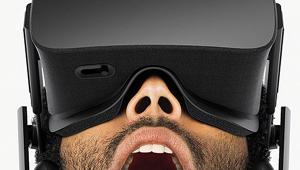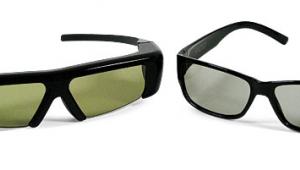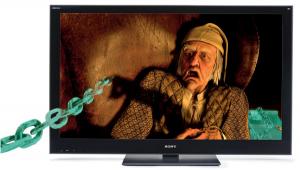Great blog....I can't wait until these technologies become affordable in the market. Artistic considerations aside, the 3-D demo that I recently saw at the local electronics store (Samsung system) convinced me that there is a future. However, Walter's comment about field of view is spot on. When I was close enough to the screen so that it was covering most of my peripheral vision, the 3-D was great. Tried to step back a bit, and it lost a lot of impact...kind of like tunnel vision.
3D For Real

The morning seminars started with Joaquin Rivera, Stewart's sales director for North American consumer products, talking about screen requirements for 3D. Any screen material will work with front-projection systems that use active-shutter glasses, but a bit of gain—say, 1.3 to 1.5—is best, since these glasses prevent about 70 percent of the light from reaching the viewers' eyes.
With passive-polarized glasses, the front-projection screen must be made of a high-gain, silver material to preserve the polarization used to differentiate the left- and right-eye images. In fact, this screen must act like a mirror, unlike conventional white or even gray screens that diffuse the light they reflect. As a result, the material includes a lot of metal, making it difficult to microperf so that speakers can be placed behind it. (Larger and more widely spaced cinema perforations are much easier to do for commercial theaters.)
Also, a silver 3D screen is far from the best material for 2D content because of color shifts, hot-spotting, and mottling. Some commercial theaters use the same screen to show polarized 3D and conventional 2D movies, but they rarely receive complaints about the 2D presentations since patrons aren't living with the system. However, this would be unacceptable for home setups, so if a passive-polarized system is installed in a home theater, it must have two screens, in which case, the 2D screen should be retractable, since the 3D screen's metal content makes it difficult to roll up and down without problems.
Next up was George Walter, Digital Projection's VP of home cinema. He started by saying that DP had developed 3D-projection technology a couple of years ago for oil- and gas-exploration applications, so the company was well positioned to enter the 3D-movie market well ahead of the curve. He also emphasized that today's 3D is not just a passing gimmick like Jaws 3D was, nor is it easily implemented, pointing out that improper use can result in headaches and other negative consequences.
According to Walter, one improper use of 3D is trying to depict fast motion. He cited experiments performed by Dolby indicating that the human brain can make sense of a 2D image in about one second, while it takes about three seconds to make sense of a simulated 3D image, so fast motion in 3D overloads the brain, causing eye fatigue and headaches.
Walter went on to say that fast motion in Avatar was essentially in 2D with little or no separation between the right and left images, while the slower environmental shots had much greater depth, which allowed most people to sit through a two-and-half-hour movie without discomfort. He also warned that the angles and camera-zoom settings in fast-moving sports must be chosen very carefully for this reason.
Another important point was that 3D requires a very large screen to be fully engaging, which is why Imax 3D is so popular. If the image doesn't occupy at least 80 percent of your field of view, your peripheral vision sees something different than what's on the screen, confusing your brain and leading to dissatisfaction with the experience. In fact, Walter is concerned that flat panels could derail the 3D market because they are so much smaller than projected images, and viewers tend to sit much farther away than they should for optimum results.
Regarding resolution, Walter said that only Blu-ray with 24fps film-based content can provide true 1920x1080 for each eye. In this case, the player sends 24fps for each eye (48fps total), alternating between left and right, a process called frame-sequential or flip-frame. The display must repeat each frame twice or three times—a process called double or triple flashing in the cinema world—to avoid flicker.
Sending 1080p at 48fps nearly maxes out HDMI's bandwidth, so another solution is to send each eye's image from a separate HDMI output. The Panasonic 3D Blu-ray player has two HDMI outputs, which are currently configured to separate the video and audio, but they could easily be updated to send dual streams to double the available bandwidth.
All other formats—including video-based Blu-ray and all broadcast content—splits the vertical or horizontal resolution in half so it fits in the same bandwidth as 1080i at 60Hz, a process called frame-compatible. The display must then extract the left and right images, upscale them to 1920x1080, and present them alternately in a frame-sequential manner.
The last presentation of the morning was from Paul Heitlinger, CTO of S1Digital, a maker of Windows-based media-server systems that work on gigabit Ethernet networks. The company's current servers offer up to 32TB of storage for Blu-rays, DVDs, CDs, and photos, though they officially support only non-copy-protected material (wink, wink, nudge, nudge—cough...AnyDVD...cough).

The client devices—some of which, such as the P600 shown here, combine a player and server—include multiple ATSC tuners and CableCard slots, and their HD DVRs can record up to four different programs simultaneously. In addition, they provide access to lots of online content, including Netflix and its new HD streaming service, and the free electronic program guide integrates broadcast and online content. Next month, the system will be upgraded to allow 3D Blu-ray content to be played.

After lunch, we were treated to several demos, including two with 3D content using active-shutter glasses from XpanD. A Digital Projection Lightning projector (pictured above) was showing Monsters vs. Aliens from a Samsung 3D Blu-ray player on a Stewart Studiotek 130 measuring 156 inches wide, while a DP Titan projector (pictured at the top of this blog) was showing clips from a Panasonic demo disc playing in a Panasonic 3D Blu-ray player on a 168-inch-wide CineCurve with Studiotek 130 material.
After some technical glitches were sorted out, both images looked spectacular—mostly. The Panasonic disc includes some shots of the Grand Canyon that were obviously not high def to begin with, but other clips from the disc looked fine. These demos were among the first to show front-projected 3D from Blu-ray using commercially available products—hence the name "3D For Real"—and they clearly illustrated the importance of a large image for effective 3D presentation.
- Log in or register to post comments

I'm curious after seeing these demo's - what your thoughts are about the dual light engine idea a couple companies were trotting around CES this year for 3D. If I remember right LG had one were introducing in a static display that was using 6 SXRD panels which seemed very odd given SXRD is sony's version of LCOS so that just may be a faulty memory of mine... Anyway would there truly be benefits of going that direction? I am curious if it so would it not be in some cases better/cheaper to stack projectors like we used to do with the old CRTs to drive a larger screen - granted given the resolution involved today getting that many pixels lined up would be a daunting task indeed!

Excellent article! Great info and it bet you and Tom had a blast. This article answered all of my questions about 3D screens. Just this weekend my wife and I were at Best Buy and we both watched 3D demos on two different HDTVs with the active-shutter glasses. One with a Samsung LED LCD and another with a Panasonic plasma. I was very impressed with both sets thats for sure! I as well as my wife preferred the plasma with 3D. Way wider viewing angle and the 3D effect on the plasma looked more impressive, not that the Samsung wasn't. Overall I am extremely excited for 3D at home. I agee that setting closer to the screen gave it a better effect. Great article once again!

For a 180" diagonal 1.3 gain screen to provide recommended luminance (14 fL) in a 3D projector, the projector would have to output at least 3000 lumens. For a more modest 110" screen, you would still need at least 1100 lumens. Even if we assume that this technology is desirable (I don't), it is not going to be available for any but very wealthy enthusiasts. Sub-$10,000 projectors with this kind of light output that offer good home theater performance simply don't exist. You need either 3-chip DLP or dual-bulb 1-chip DLP, LCoS or LCD. We are talking $30,000 and up.
























































